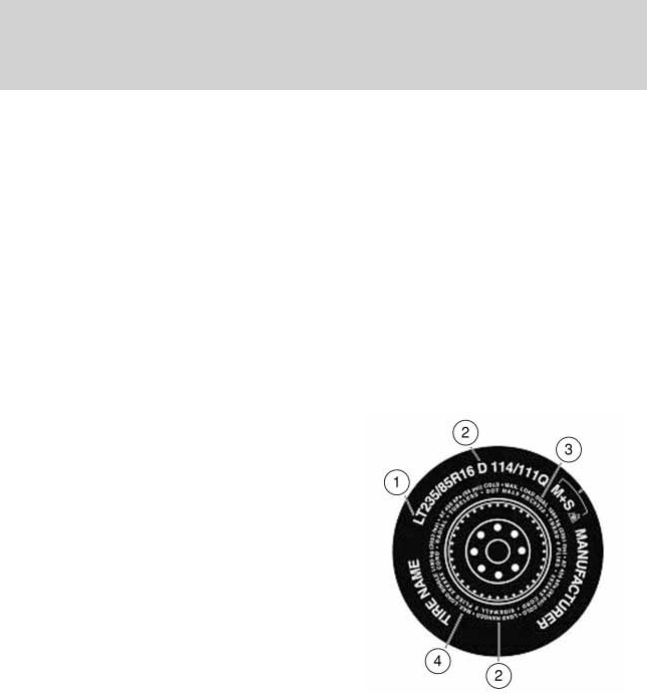Ford 2009 Ranger v.2 Manuel d'utilisateur Page 131
- Page / 274
- Table des matières
- MARQUE LIVRES
Noté. / 5. Basé sur avis des utilisateurs



13. Maximum Permissible Inflation Pressure: Indicates the tire
manufacturers’ maximum permissible pressure and/or the pressure at
which the maximum load can be carried by the tire. This pressure is
normally higher than the manufacturer’s recommended cold inflation
pressure which can be found on the Safety Compliance Certification
Label or Tire Label which is located on the B-Pillar or the edge of the
driver’s door. The cold inflation pressure should never be set lower than
the recommended pressure on the vehicle label.
The tire suppliers may have additional markings, notes or warnings such
as standard load, radial tubeless, etc.
Additional information contained on the tire sidewall for “LT” type
tires
“LT” type tires have some additional
information beyond those of “P”
type tires; these differences are
described below.
Note: Tire Quality Grades do not
apply to this type of tire.
1. LT: Indicates a tire, designated by
the Tire and Rim Association
(T&RA), that is intended for service
on light trucks.
2. Load Range/Load Inflation
Limits: Indicates the tire’s
load-carrying capabilities and its
inflation limits.
3. Maximum Load Dual lb. (kg) at psi (kPa) cold: Indicates the
maximum load and tire pressure when the tire is used as a dual; defined
as four tires on the rear axle (a total of six or more tires on the vehicle).
4. Maximum Load Single lb. (kg) at psi (kPa) cold: Indicates the
maximum load and tire pressure when the tire is used as a single;
defined as two tires (total) on the rear axle.
2009 Ranger (ran)
Owners Guide, 2nd Printing
USA (fus)
Tires, Wheels and Loading
131
- Table of Contents 1
- Introduction 10
- Instrument Cluster 12
- Entertainment Systems 19
- Climate Controls 41
- Driver Controls 54
- Locks and Security 63
- Seating and Safety Restraints 100
- Tires, Wheels and Loading 116
- 2009 Ranger (ran) 154
- Owners Guide, 2nd Printing 154
- USA (fus) 154
- Roadside Emergencies 179
- Customer Assistance 209
- Cleaning 216
- (R+M)/2 METHOD 245
- XXXXXXXXXXXXXXXXX 265
- Accessories 267
 (308 pages)
(308 pages)







Commentaires sur ces manuels